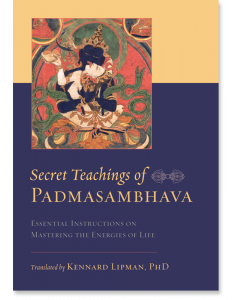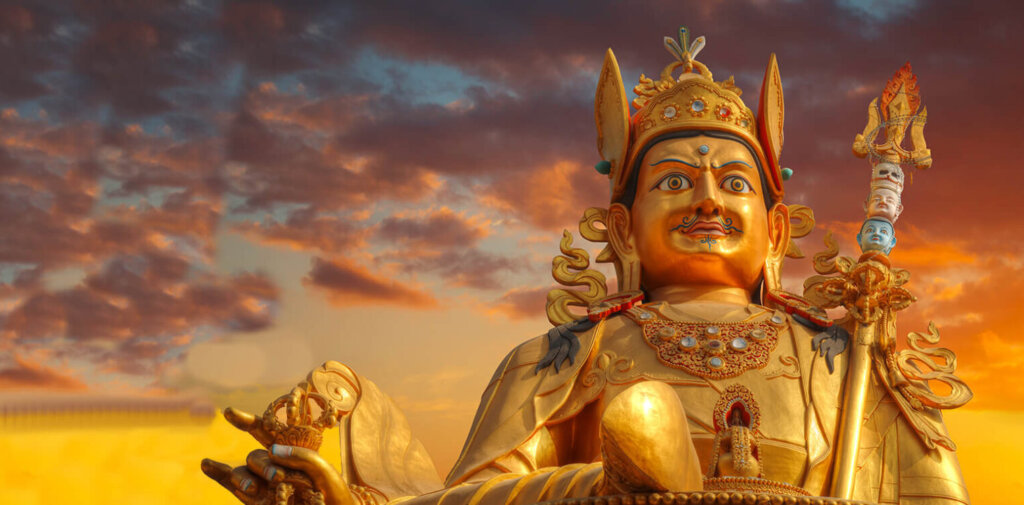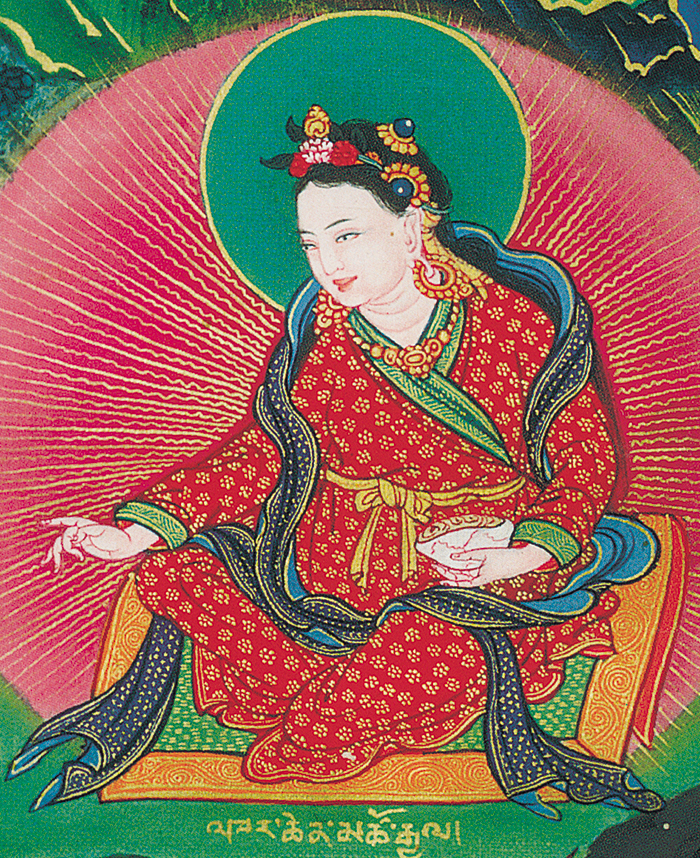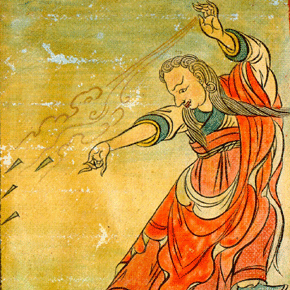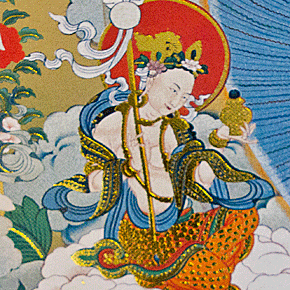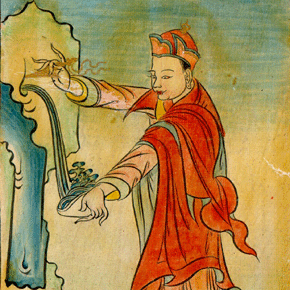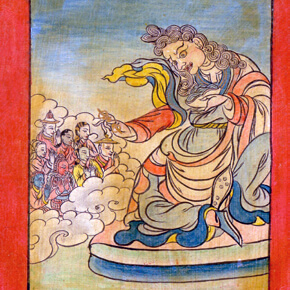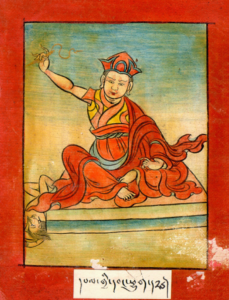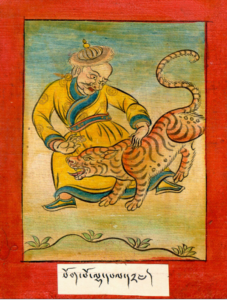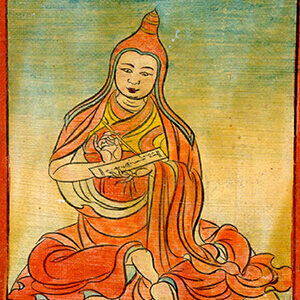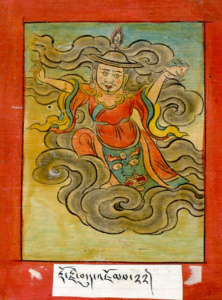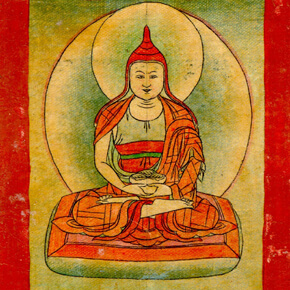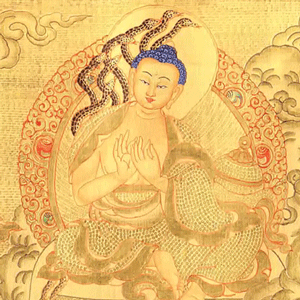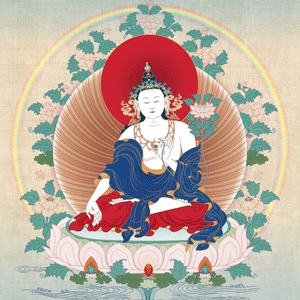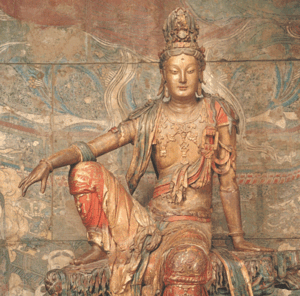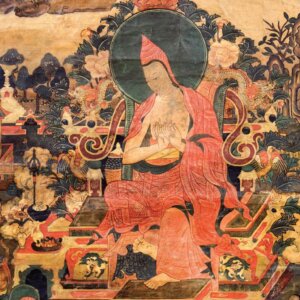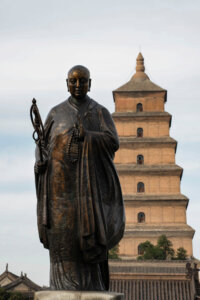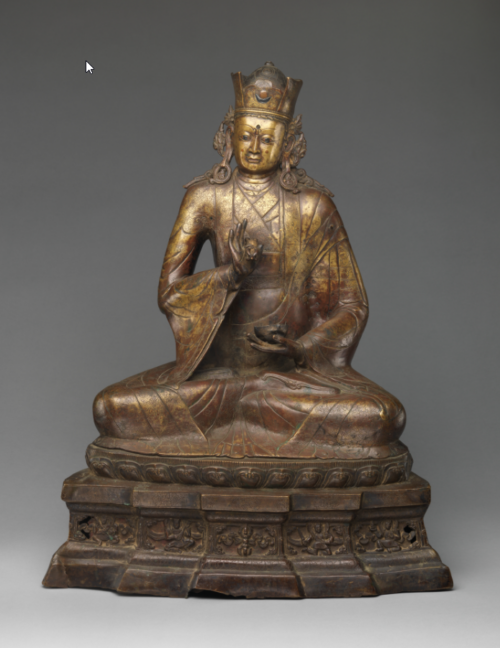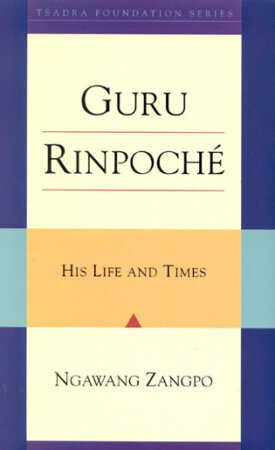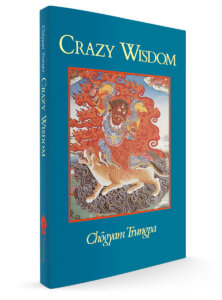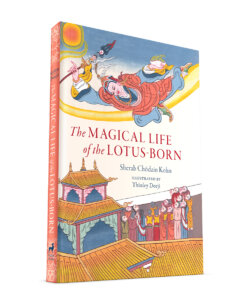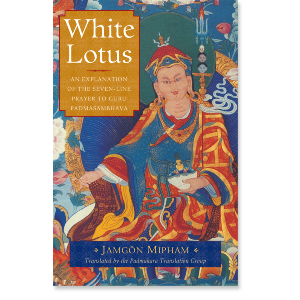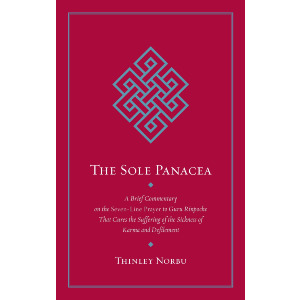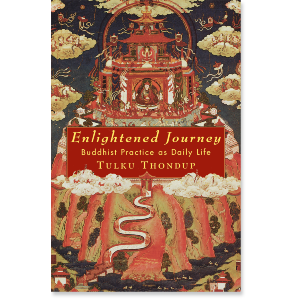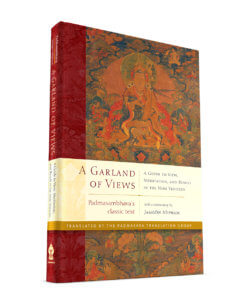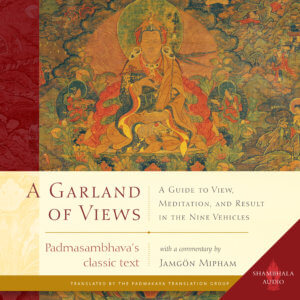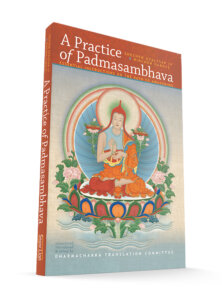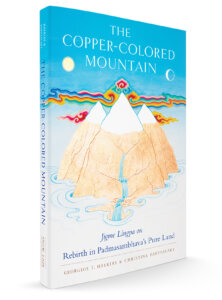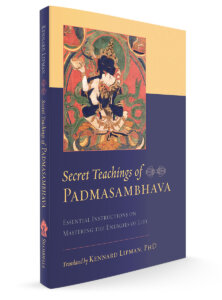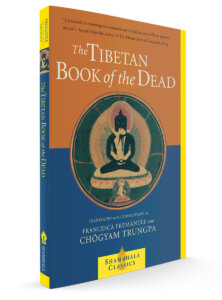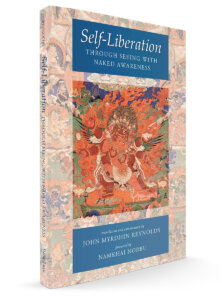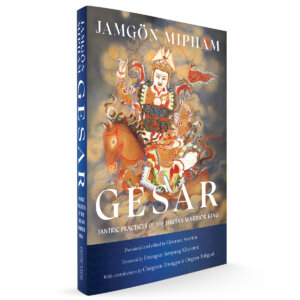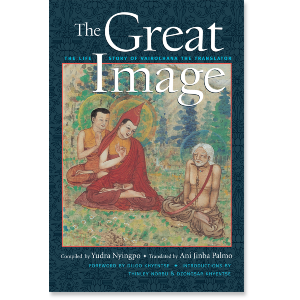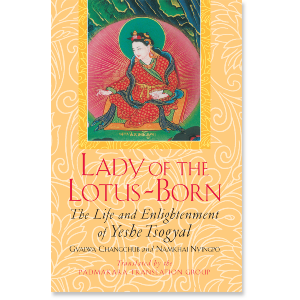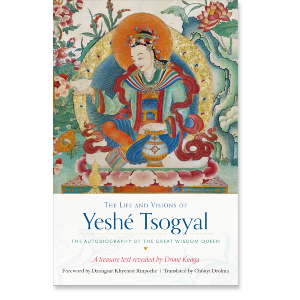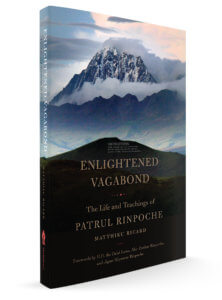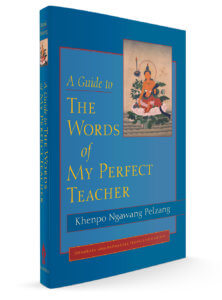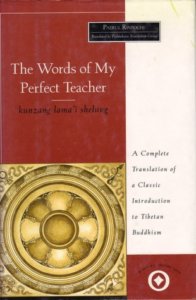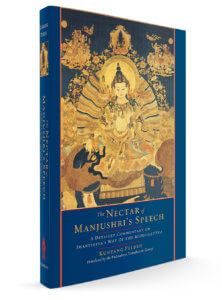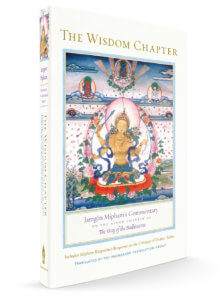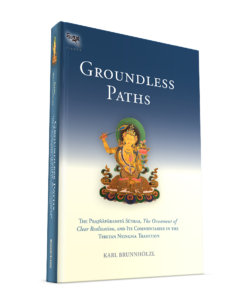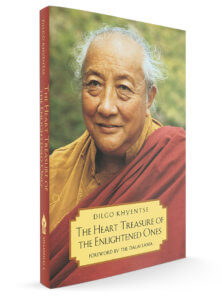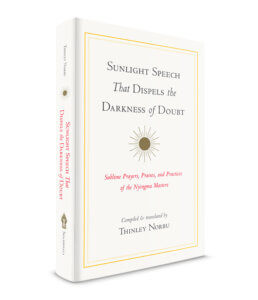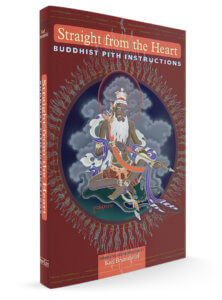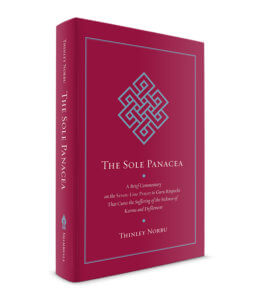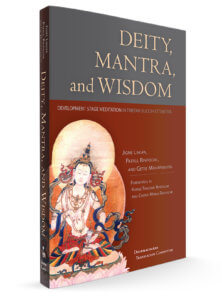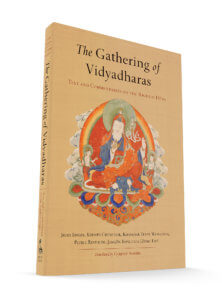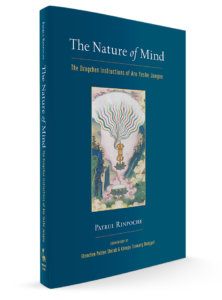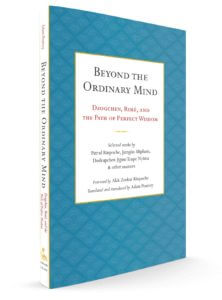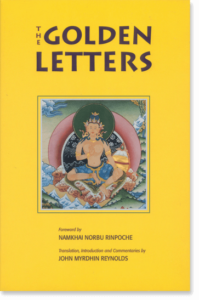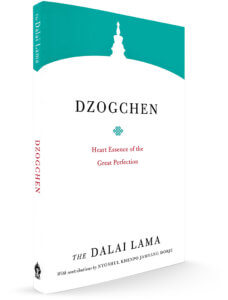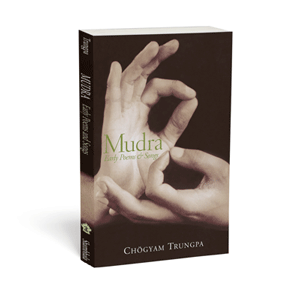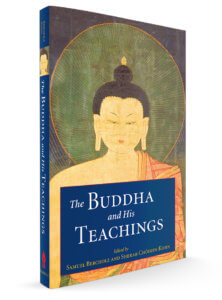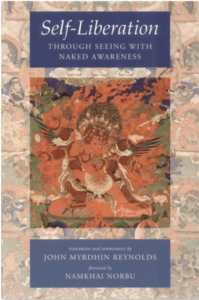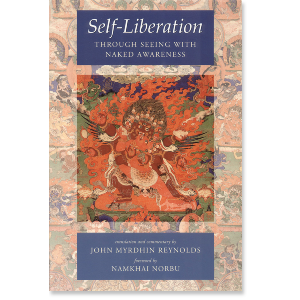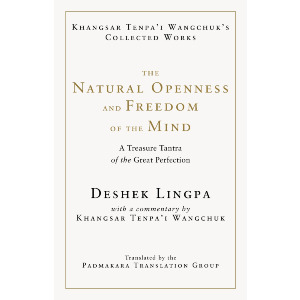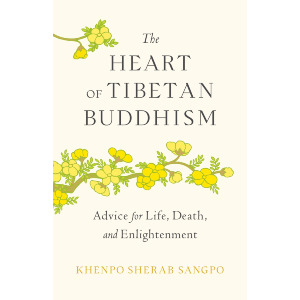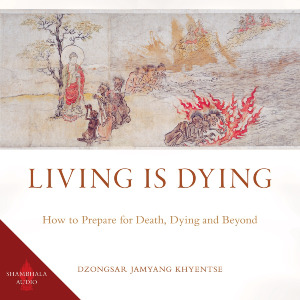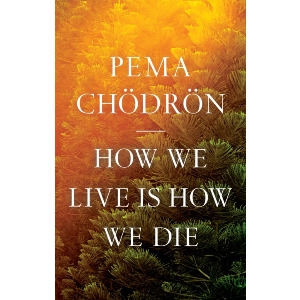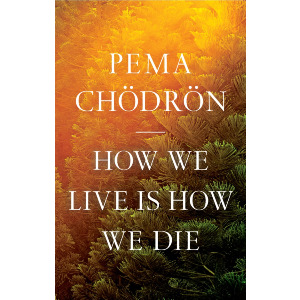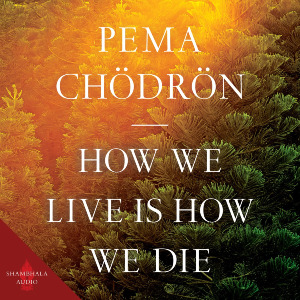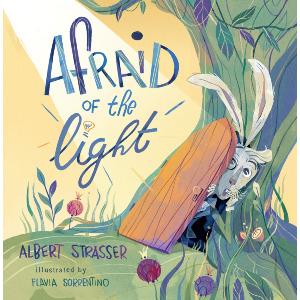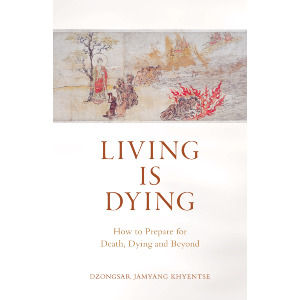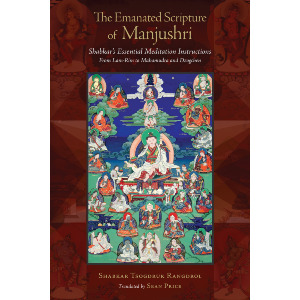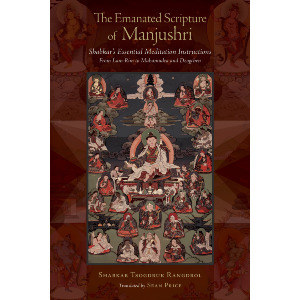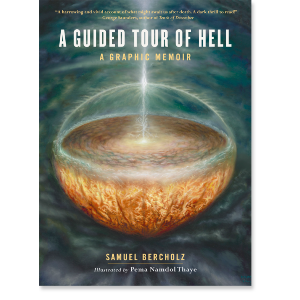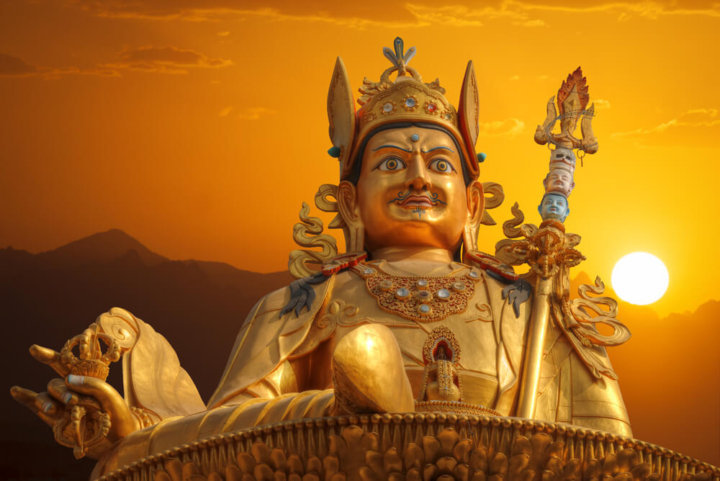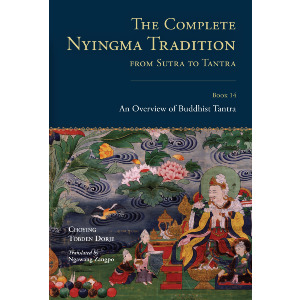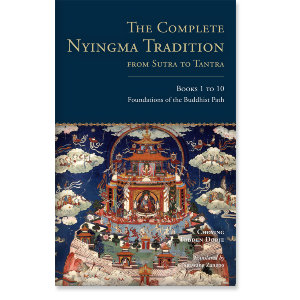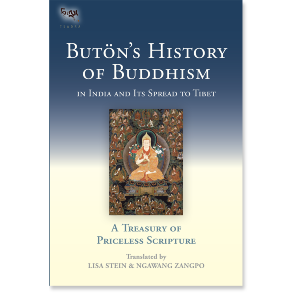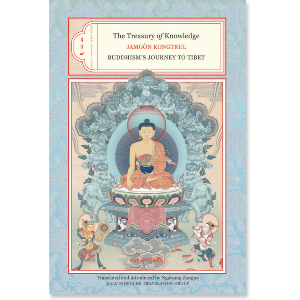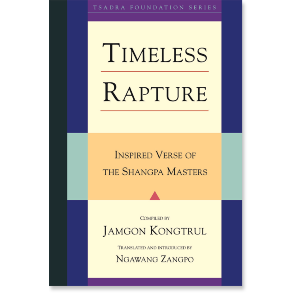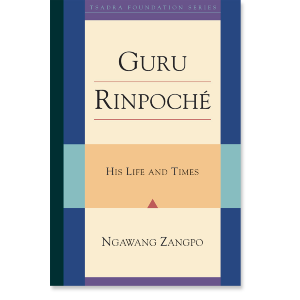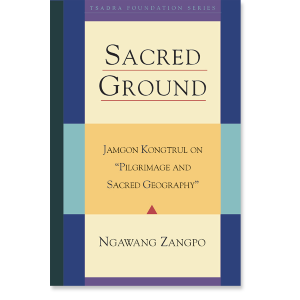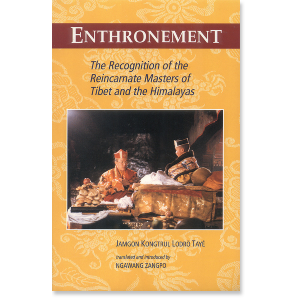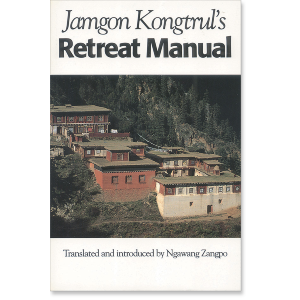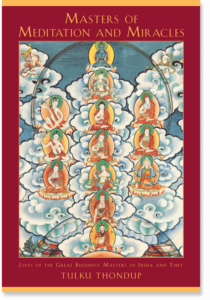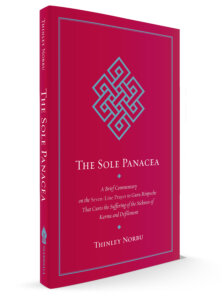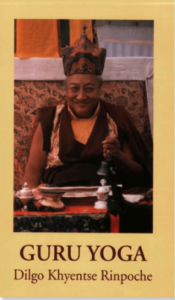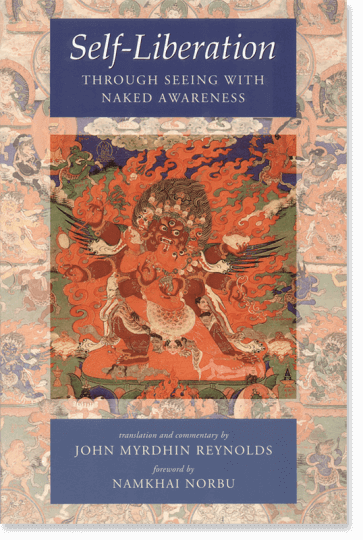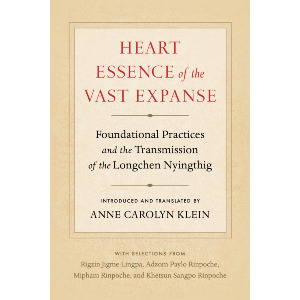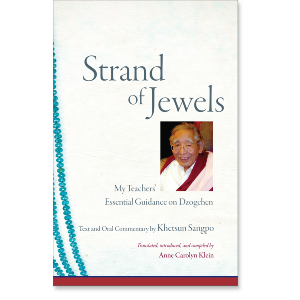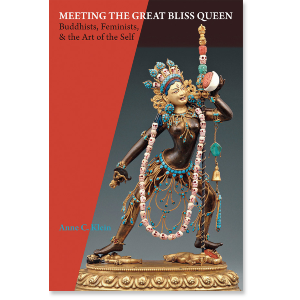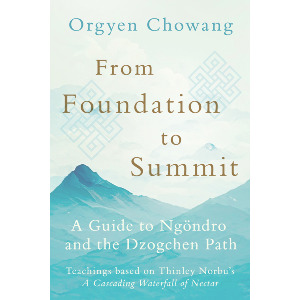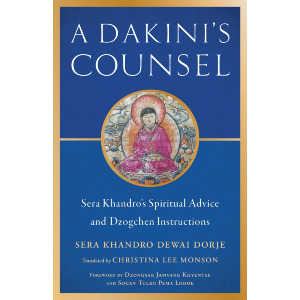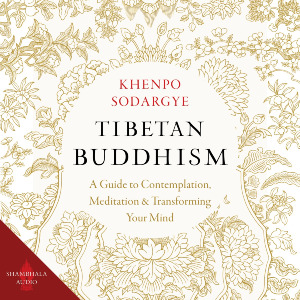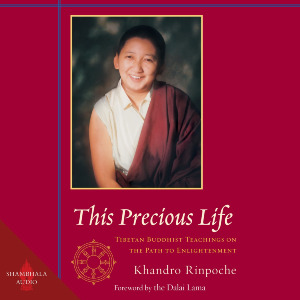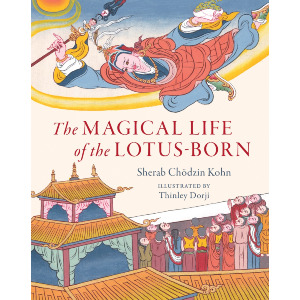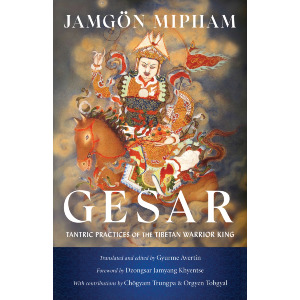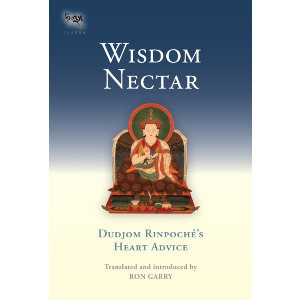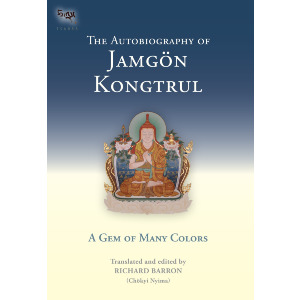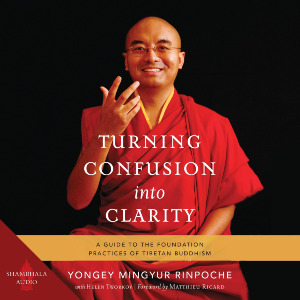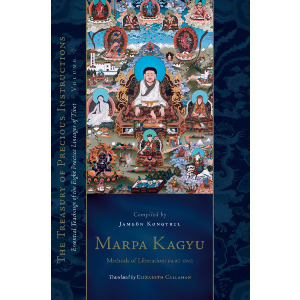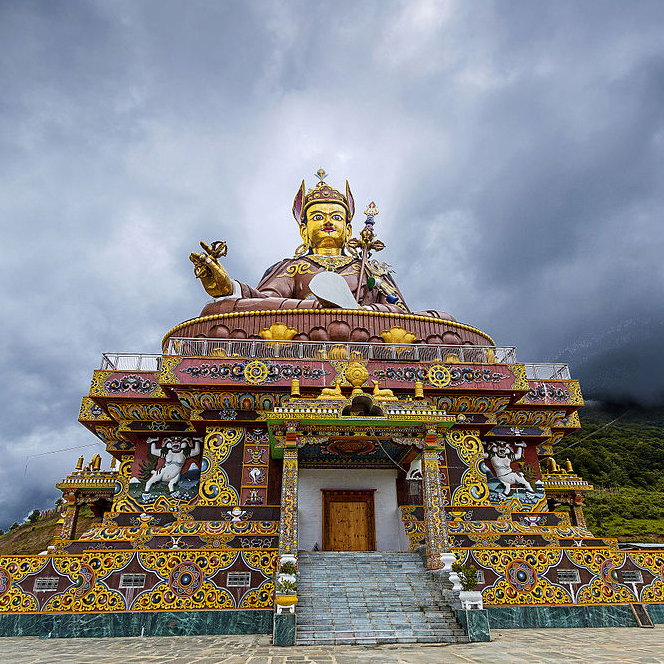

Padmasambhava
Padmasambhava (eighth century), the Indian meditation master, is the founder of the Nyingma tradition, the oldest Buddhist tradition in Tibet. In addition to introducing the practices of tantric Buddhism to Tibet, he also completed the building of Samye, the first Buddhist monastery in Tibet.
Padmasambhava
-
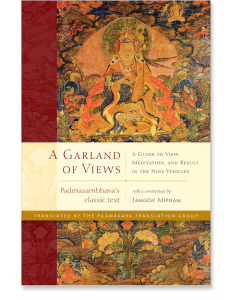 A Garland of Views$22.95- Hardcover
A Garland of Views$22.95- HardcoverBy Padmasambhava
By Jamgon Mipham
Translated by Padmakara Translation Group -
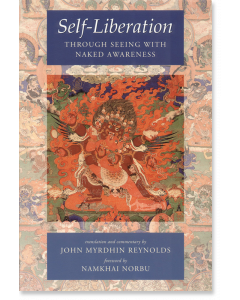 Self-Liberation through Seeing with Naked Awareness$24.95- Paperback
Self-Liberation through Seeing with Naked Awareness$24.95- PaperbackBy Padmasambhava
By Karma Lingpa
Translated by John Myrdhin Reynolds
Foreword by Chogyal Namkhai Norbu
GUIDES
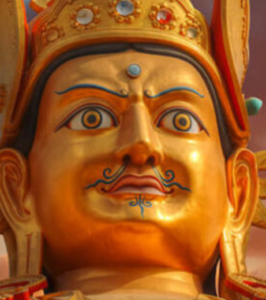
Tibetan Masters of the 8th Century

Masters of the 8th Century
Tibetan Masters of the Eighth Century
The eighth century was an incredible flouring of the Dharma in Tibet with special thanks to Guru Rinpoche Padmasambhava, King Trisong Deutsen, and Shantarakshita. The figures in this section includes some of Guru Rinpoche's famed 25 disciples. The full list is as follows:
King Trisong Detsen, Namkhe Nyingpo, Nubchen Sangye Yeshe, Gyalwa Chogyang, Yeshe Tsogyal, Palgyi Yeshe, Langchen Palgyi Senge, Vairotsana, Nyak Jñānakumāra, Yudra Nyingpo, Nanam Dorje Dudjom, Yeshe Yang, Sogpo Lhapal, Nanam Zhang Yeshe De, Kharchen Palgyi Wangchuk, Denma Tsemen, Kawa Paltsek, Shupu Palgyi Senge, Gyalwe Lodrö, Drogben Khyeuchung Lotsawa, Odren Palgyi Wangchuk, Ma Rinchen Chok, Lhalung Palgyi Dorje, Langdro Könchok Jungne, Lasum Gyalwa Jangchub.
We continue to add Reader Guides to this section.
Guru Rinpoche, Padmasambhava
8th century
The great master from India whose centrality to Tibetan Buddhism through his establishing Buddhism in Tibet and his legacy of teachings that continues to unfold cannot be overstated.
Yeshe Tsogyal
8th century
The great princess turned queen who, as a supreme disciple of Guru Rinpoche, was possibly the first person to achieve liberation in Tibet.
Langdro Konchok Jungne
8th century
Also known as Langdro Lotsawa, he was minister in the court of King Trisong Deutsen.
Lang Pelgyi Senge
8th century
Also known as Lhalung Pelgyi Senge, should not be confused with another Pelgyi Senge who was his contemporary.
Sokpo Pelgyi Yeshe
8th century
Also known as Sokpo Lhapal, was a direct disciple of both Guru Rinpoche and Nyak Jnanakumara and then later became the teacher of Nupchen Sangye Yeshe.
Denma Tsemang
8th century
Another of Guru Rinpoche's 25 chief disciples, famed for his calligraphy and, later, his translation skills and of course his practice.
Nanam Dorje Dudjom
8th century
A minister to King Trisong Detsen while still a young man, he was part of the party that invited Padmasambhava to Tibet.
Kawa Peltsak
8th century
Another of Guru Rinpoche's 25 chief disciples, famed for his translations , including Shantideva's Bodhicharyavatara.
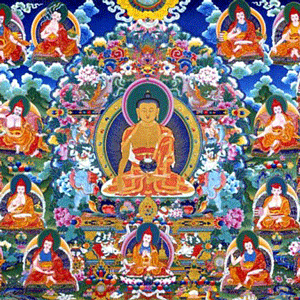
Indian Mahayana Masters of the 2nd-8th Centuries

The Indian Masters
Indian Mahayana Masters from the 2nd-8th Centuries
The Tibetan traditions all look back to India as the source of wisdom. There were countless masters all over India, north and south, east (including present-day Bangladesh) and west (including present-day Pakistan). The Mahayana reached its full expression during this period, and what follows is a partial but growing list of Reader Guides to these masters.
The Seventeen Pandits of Nalanda
2nd through 11th centuries
Tibetan Buddhism is none other than the Buddhism of India in the tradition of Nalanda, the great center of Buddhist learning that was located in present-day Bihar, India. There are seventeen great scholars profiled here, including Nagarjuna, Aryadeva, Asanga, Vasabandhu, Buddhapalita, Dignaga, Bhavaviveka, Vimuktisena, Chandrakirti, Dharmakirti, Shantideva, Shantarakshita, Kamalashila, Haribhadra, Gunaprabha, Shakyaprabha. and Atisha.
Nagarjuna
(2nd century....and beyond)
The great master closely associated with the Perfection of Wisdom
Shantideva and the Way of the Bodhisattva
8th century
The great master Shantideva is the author of two very important texts. The first is the Śikṣāsamuccaya, or Training Anthology which is a compilation of many works. The second is the Bodhicharyavatara, or Way of the Bodhisattva. This Reader Guide focuses on the latter work.
Asanga
4th century
The great Mahayana figure who is a key explicator of Yogacara, and also received the Five Maitreya texts from Maitreya.
Xuanzang (602-664 CE)
7th century
While not an Indian master, we wanted to include Xuanzang, certainly one of the most important figures in Buddhist history. His 16 year pilgrimage from his home in China throughout the Buddhist world is almost The Odyssey of the Buddhist literature. His translation and preservation of texts, as well as the account of his journey, had come down to us through the ages and is well worth a deep exploration.
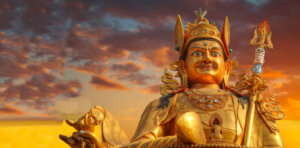
Padmasambhava: A Reader's Guide to Guru Rinpoche

Some Nyingma Lineages: Dudjom Tersar | Longchen Nyingtig | Namcho & Palyul
Guides to Other Important Nyingma Figures:
Rongzompa | Longchenpa | Jigme Lingpa | Patrul Rinpoche |
Sera Khandro | Mipham Rinpoche | Dilgo Khyentse | Dudjom Rinpoche
We begin this Reader’s Guide to Guru Rinpoche, also known as Padmasambhava, with some trepidation, as it is a delicate task to try and write a short article on a figure so central to the Tibetan Buddhist tradition and so revered by many, whose life and legacy are so rich. The attempt feels deficient, yet there are some great resources for practitioners that are important to highlight. Also, so many termas, or rediscovered treasures are in fact from Guru Rinpoche, that excluding them feels a bit odd but to include them would be overwhelming. In fact, there are few books in the Nyingma tradition where Guru Rinpoche is not a central figure.
This guide presumes readers already have a basic understanding of Guru Rinpoche, and how he is an historical figure and saint, considered a Buddha as well a focus of meditation in the form of the Guru, and the source of an incredible corpus of teachings.
Biographical Accounts
Hardcover | Ebook
$28.95 - Hardcover
Guru Rinpoche: His Life and Times
Introduced and translated by Ngawang Zangpo
The first half of the book includes six chapters where Ngawang Zangpo lays out an important framework for understanding Guru Rinpoche's impact and the mileiu he entered on his arrival to Tibet. These include:
- Buddhism, History, and the Truth
- Buddhist History after the Buddha
- Tibet and Asia on the Eve of Guru Rinpoché’s Arrival
- India in Guru Rinpoché’s Era
- Guru Rinpoché Now—in Print
- Timeless Guru Rinpoché and Wisdom Bridges to the Present
There are many account of Guru Rinpoche's life, and the second half of the book is collection of vitally important accounts about his life is an invaluable resource.
- A Biography of Guru Rinpoche by Jamgon Kongtrul
- The Immaculate White Lotus by Dorje Tso
- The Indian Version of the Life of Guru Rinpoche by Taranata
- The Bön Version of the Life of Guru Rinpoche by Jamyong Kyentse Wongpo
- Supplications to Guru Rinpoche in Seven Chapters by Guru Rinpoche
- Visualizations to Accompany the Supplications by Jamgon Kongtrul
Paperback | Ebook
$21.95 - Paperback
Crazy Wisdom
This fascinating book examines the life of Padmasambhava to illustrate the principle of "crazy wisdom". From this profound point of view, spiritual practice does not provide comfortable answers to pain or confusion. On the contrary, painful emotions can be appreciated as a challenging opportunity for new discovery. In particular, the author discusses meditation as a practical way to uncover one's own innate wisdom.
He uses the model of the Eight Names (or aspects of manifestations) of Guru Rinpoche, and goes through each in detail.
Trungpa Rinpoche makes a strong case that those in the west need Padmasabhava as badly as the savage and uncultured Tibetans of the eighth century.
Hardbound | Ebook
$21.95 - Hardcover
The Magical Life of the Lotus-Born
By Sherab Chodzin Kohn, illustrated by Thinley Dorji
Explore a fresh telling of the inspiring, mysterious, and magical life of the great master Padmasambhava—the Lotus-Born—who planted the seed of Buddhism in Tibet that is still blossoming today, beautifully illustrated for ages 10+.
Here, his magical life story is outlined in colorful and captivating detail, offering young readers a rare glimpse into his fierce adventures and battles that transformed Tibet, a land of malevolent spirits and wild folk, into a fertile ground for Buddhism. The rich and vibrant spiritual tradition that resulted in Tibet has thrived for over one thousand years. This timeless tale is sure to capture the imagination of future generations, just as the oral, theatrical, and written accounts of it have in the Himalayas for centuries.
The Seven Line Prayer
The Seven-Line prayer to Guru Rinpoche is one of the most ubiquitous and important prayers, performed across lineages and in particular the Nyingma tradition who commence nearly every practice with it and for which there are dedicated sadhanas based on it. Below are several of the books about it.
Visit our page dedicated to resources about the famed Seven Line Prayer
$18.95 - Paperback
Works and Practices Related to Padmasambhava
Hardcover | Ebook
$22.95 - Hardcover
A Garland of Views: A Guide to View, Meditation, and Result in the Nine Vehicles
by Padmasambhava and Mipham Rinpoche
A Garland of Views presents both a concise commentary by the eighth-century Indian Buddhist master Padmasambhava on a chapter from the Guhyagarbha Tantra on the different Buddhist and non-Buddhist philosophical views, including the Great Perfection (Dzogchen), and an explicative commentary on Padmasambhava’s text by the nineteenth-century scholar Jamgön Mipham (1846–1912).
Padmasambhava’s text is a core text of the Nyingma tradition because it provides the basis for the system of nine vehicles (three sutra vehicles and six tantra vehicles) that subsequently became the accepted way of classifying the different Buddhist paths in the Nyingma tradition.
Padmakara Translation Group translator Stephen Gethin on Garland of Views
Audiobook Sample
Audiobook (read by British actor Simon Callow)
$24.99 - Digital Audio
Paperback | Ebook
$21.95 - Paperback
A Practice of Padmasambhava: Essential Instructions on the Path to Awakening
A Practice of Padmasambhava presents two practical and compelling works related to a visualization and mantra practice of Padmasambhava. This practice is based on the most important revelation of the renowned nineteenth-century treasure revealer Chokgyur Lingpa, Accomplishing the Guru's Mind: Dispeller of All Obstacles. These two works give an introduction to the preliminary trainings, outline the primary elements of visualization practice and mantra recitation, and supply a detailed explanation of the practice of Padmasambhava's wisdom aspect, Guru Vadisimha. Through practical step-by-step instructions on this deity, the reader is guided into the general world of tantric practice common to all of Tibetan Buddhism.
Paperback | Ebook
$29.95 - Paperback
The Copper-Colored Mountain: Jigme Lingpa on Rebirth in Padmasambhava’s Pure Land
By Jigme Lingpa, George Halkias, and Christina Partsalaki
The Copper-Colored Mountain is the pure land of Padmasambhava, the Indian master who brought Buddhism to Tibet. One way in which Buddhist practitioners may be reborn in this pure land is by making aspiration prayers. This work includes a translation of one of the most famous of these aspiration prayers, composed by Jigme Lingpa, and the authors’ verse-by-verse analysis of it. Drawing on both traditional commentaries and contemporary scholarly texts, the authors show how Jigme Lingpa encodes many features of Tibetan Buddhist tantric practice in these verses, and thus they provide a feast of meaning for tantric practitioners.
Paperback | Ebook
$18.95 - Paperback
Secret Teachings of Padmasambhava: Essential Instructions on Mastering the Energies of Life
By Padmasambhava, translated by Kennard Lipman
Translations of several short but important texts on Innermost Essence of the Dakini (Khadro Nyingtig).
These two teachings of Padmasambhava, The Fivefold Essential Instruction and A Section of Hidden Instruction, the Innermost Essence of the Dakini, are certainly of interest to the serious practitioner of the Vajrayana. They not only present well-known tantric teachings of channels (tsa), energy (lung), and potencies (tigle) in a clear and practical way, but they also offer us a unique Dzogchen perspective on them. In addition, they give us a glimpse into life on retreat with two of the greatest masters of Tibetan Buddhism, Padmasambhava and Yeshe Tsogyal.
Paperback | Ebook
$16.95 - Paperback
The Tibetan Book of the Dead: The Great Liberation through Hearing in the Bardo
By Padmasambhava, Karma Lingpa. Translated and introduced by Chögyam Trungpa and Francesca Freemantle
Written by Guru Rinpoche, rediscovered as a terma by Karma Lingpa, and translated and introduced by Chögyam Trungpa and Francesca Freemantle, this work is traditionally read aloud to the dying to help them attain liberation—death and rebirth are seen as a process that provides an opportunity to recognize the true nature of mind. This translation of The Tibetan Book of the Dead emphasizes the practical advice that the book offers to the living. The insightful commentary by Chögyam Trungpa, written in clear, concise language, explains what the text teaches us about human psychology.
Paperback | Ebook
$24.95 - Paperback
Self-Liberation through Seeing with Naked Awareness
By Padmasambhava, Karma Lingpa, and John Myrdhin Reynolds
Teaching the attainment of Buddhahood in a single lifetime, this text was written and concealed by Guru Padmasambhava in the eighth century and rediscovered six centuries later by Karma Lingpa. The commentary by the translator is based on the oral teachings of Namkhai Norbu Rinpoche and Lama Tharchin Rinpoche.
Paperback | Ebook
$29.95 - Paperback
Gesar: Tantric Practices of the Tibetan Warrior King
By Mipham Rinpoche, Orgyen Tobgyal Rinpoche, Chogyam Trungpa. Introduced and translated by Gyurme Avertin
The King, protector, and deity Gesar of Ling is intimately connected with Guru Rinpoche. In his Garland of Jewels, Mipham Rinpoche explains that "The lords of the three families are Manjushri, Avalokiteshvara, and Vajrapani; their magical manifestation is Guru Rinpoche; and his emanation is Gesar Norbu Dradul. As Gesar prayers often specify, the 'emanation of Padma and the three families, Great Lion Gesar." This work explains the connection in several sections.
Orgyen Tobgyal relates:
Basically, the deity Gesar doesn’t exist; he is simply Guru Rinpoche in the form of a drala—a form he takes to help raise the windhorse of sentient beings. Guru Rinpoche is also the embodiment of the enlightened qualities of all the buddhas. His enlightened activities are unfathomable, but a small fraction took place in the Land of Ling, 'the awe-inspiring Ma valley' in Kham—this is what it’s called in all the stories written about Gesar.
Books on Some of Guru Rinpoche's Contemporaries
$34.95 - Paperback
By: Gyalwa Changchub & Namkhai Nyingpo & Padmakara Translation Group
The Life and Visions of Yeshe Tsogyal
$24.95 - Paperback
By: Chonyi Drolma & Dzongsar Jamyang Khyentse & Drime Kunga & Yeshe Tsogyal
We also encourage readers to explore the excellent series of books on Padmasambhava, Following in Your Footsteps, published by Rangjung Yeshe Publications.
Additional Resources

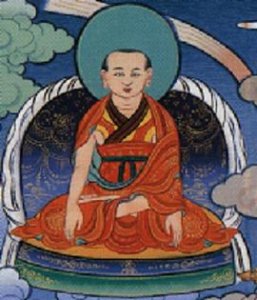
Patrul Rinpoche: A Reader's Guide

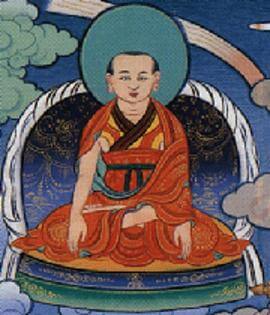
Praise to Patrul Rinpoche
Outwardly, you are the Son of the Victorious Ones, Shantideva.
Inwardly, you are the saint, the conqueror Shavaripa.
Secretly, you are the supreme sublime being Dug-ngal Rangdröl, actual self-liberator of the suffering of beings.
Jigme Chökyi Wangpo, I pray to you.
— by Jamyang Khyentse Wangpo, from Thinley Norbu Rinpoche's Sunlight Speech That Dispels the Darkness of Doubt
Jump To: His Life | Foundations | Propitious Speech | Mahayana | Tantra | Dzogchen | More
The Life of Patrul Rinpoche
Eastern Tibet in the nineteenth century was teeming with some of the most remarkable teachers to have walked on this earth.
Standing vividly out among them was Dza Patrul Orgyen Jigme Chökyi Wangpo, commonly known to us as Patrul Rinpoche. Considered one of the three main incarnations of Jigme Lingpa, the impact that this wandering yogi made on Buddhist practice cannot be overstated.
Biographical sketches of him can be found in Tulku Thondup's Masters of Meditation and Miracles, Khenpo Kunpel's A Vase of Nectar to Inspire the Faithful: A Biography of Patrul Rinpoche, Nyoshul Khen Rinpoche's A Marvelous Garland of Gems, Alak Zenkar Rinpoche's brief biography on Lotsawa House, and as several of the works listed below.
But perhaps the best place to start is in Matthieu Ricard's Enlightened Vagabond: The Life and Teachings of Patrul Rinpoche. Ricard has spent his life with some of the most amazing teachers of the 20th century, many of them heirs to the practice tradition of Patrul Rinpoche and the oral tradition preserving the stories of Patrul Rinpoche, which have been told since his days as a peripatetic wandering in the hills and mountains of eastern Tibet. This book is filled with stories and teachings that will make you laugh and cry and leave you in awe. It is an essential book for those inspired by Patrul Rinpoche's life, works, and wisdom.
What follows is a guide for readers to many of the works available in English by Patrul Rinpoche.
Foundations
The Foundations: Ngöndro
The Words of My Perfect Teacher, or Kunzang Lama'i Shelung, must be one of the most influential works to come out of Tibet. For westerners, the translations, first by Sonam Kazi and then later by the Padmakara Translation Group, have been instrumental in our Buddhist education. In this work Patrul Rinpoche puts to paper a long oral tradition on the preliminary or foundational practices, from the Four Thoughts that turn the mind to Dharma to refuge, bodhicitta, mandala offerings, purification relying on Vajrasattva, and Guru Yoga. It is full of stories that drive the points home in a way that go right to the reader's heart. Lamas have said that this book has a particular quality that rereading it nearly always gives the reader a new discovery. And revisiting it again and again is how it is meant to be used—this is not a work to check the box that you have read it, but for it to become part of the one studying it.
And to go even deeper with it, Kathog Khenpo Ngawang Pelzang, who received it in his youth from Patrul Rinpoche's heart disciple Lungtok Tenpai Nyima, wrote his Zintri, or notes, that form The Guide to the Words of My Perfect Teacher. This work presents the background for the teachings of the main work. For example Patrul Rinpoche's chapter on the Three Jewels corresponds to this work's in-depth exposition on the finer points of the Three Jewels and Patrul Rinpoche's chapter on the mandala offering is complemented by Khenpo's chapter on Buddhist cosmology. Together these two works provide a multi-faceted overview of how to practice.
The Mahayana
While Patrul Rinpoche is famed as a Dzogchen yogi, at the core of his practice was the Mahayana ideal of the bodhisattva, a path he truly lived. It is said that Patrul Rinpoche traveled alone, carrying two texts with him. The first was The Way of the Bodhisattva. The second was Nagarjuna's Root Stanzas of the Middle Way.
The Nectar of Manjusri's Speech: A Detailed Commentary on Shantideva's Way of the Bodhisattva
by Khenpo Kunzang Pelden, based on Patrul Rinpoche's teachings
While Patrul Rinpoche did not compose a work on the Way of the Bodhisattva, he taught it constantly, over one hundred times from beginning to end. It had fallen into disuse outside a few monastic centers, and it is thanks to Patrul Rinpoche this text became integral to all the schools of Tibetan Buddhism. Luckily for us, one of his most dedicated students, Khenpo Kunzang Pelden or Khenpo Kunpel, compiled these teachings he received from Patrul Rinpoche and composed The Nectar of Manjusri's Speech: A Detailed Commentary on Shantideva's Way of the Bodhisattva.
The Wisdom Chapter
by Mipham Rinpoche, based on teachings he received from Patrul Rinpoche
Patrul Rinpoche, also imparted teachings to Mipham Rinpoche, who based his understanding on these when he wrote his commentary on the famous (and famously challenging) ninth chapter of The Way of the Bodhisattva, now translated as The Wisdom Chapter.
Groundless Paths: The Prajnaparamita Sutras, The Ornament of Clear Realization, and Its Commentaries in the Tibetan Nyingma Tradition
by Karl Brunnholzl, with extensive translations and analysis of Patrul Rinpoche's work
On the Abhisamayālaṃkāra, one of the Five Maitreya Texts imparted to Asanga by Maitreya himself, Patrul Rinpoche wrote seven texts, the main two of which are The General Topics on the Abhisamayālaṃkāra and A Word Commentary on the Abhisamayālaṃkāra. What will be surprising for some, the bulk of these two works are, in the honored Tibetan tradition of honoring the words of past masters, is almost entirely excerpts from Tsongkhapa's commentary on the text, The Golden Garland of Explanations.
A distillation (if a 900 page work can be called that) of Patrul Rinpoche's works on this text, are what forms the bulk of Groundless Paths: The Prajñāpāramitā Sūtras, The Ornament of Clear Realization, and Its Commentaries in the Tibetan Nyingma Tradition
Watch scholar and translator Karl Brunnholzl discuss the trilogy of commentaries on Prajaparamita, of which Groundless Paths, heavily focused on Patrul Rinpoche, is the third volume.
The Speech Virtuous in the Beginning, Middle, and End
The Speech Virtuous in the Beginning, Middle, and End, one of the most influential works of Patrul Rinpoche, is included is included in whole or in part in several books. Patrul Rinpoche wrote this while staying in a remote cave not far from the Tibetan-Chinese border. In this work, be pulls the rug from under our normal way of being, so full of deceit and hypocrisy. He concludes that only by turning away from an ordinary life and pursuing the path of Buddhism. He then outlines the preliminary practices, the development and completion stages of tantric practice, and finally the practices of Mahamudra and Dzogchen. This text is full of the wisdom, humor, and directness that characterize all of Patrul Rinpoche's works, but it is unique in that it is meant to be memorized, making its message easy to bring right into our hearts.
The Heart Treasure of the Enlightened Ones
The Practice of View, Meditation, and Action
A commentary on Patrul Rinpoche's teachings by Dilgo Khyentse Rinpoche
In the accompanying commentary to Patrul Rinpoche's root text, Dilgo Khyentse Rinpoche (1910–1991)—lineage holder of the Nyingma school and one of the great expounders of the Dharma in Europe and North America—expands upon the text with his characteristic compassion and uncompromising thoroughness. Patrul Rinpoche's fresh and piercing verses combined with Khyentse Rinpoche's down-to-earth comments offer a concise yet complete examination of the Buddhist path.
Sunlight Speech That Dispels the Darkness of Doubt
Sublime Prayers, Praises, and Practices of the Nyingma Masters
Trasnlated by Thinley Norbu Rinpoche
Another superb translation of the root text of Patrul Rinpoche's The Practice of the View, Meditation, and Action, Called “The Sublime Heart Jewel”, The Speech Virtuous in the Beginning, Middle, and End is included in Thinley Norbu Rinpoche's collection of translations entitled Sunlight Speech That Dispels the Darkness of Doubt. This text presents advice to practitioners on the path to enlightenment, which is all contained in the three aspects of the correct view, meditation, and action, synthesized in the practice of the Six-Syllable Mantra of Avalokiteshvara.
Two poems of Patrul Rinpoche are included in what in the mind of your author here is one of the most extraordinary anthologies of Tibetan Buddhism: Straight from the Heart: Buddhist Pith Instructions.
The first poem is an excerpt from Speech That Is Virtuous (see the entry from Sunlight Speech in this article) and the translator has titled it Afflictions Are Wisdom, the Skandhas Are Avalokitesvara. The second is The Crucial Point of Practice.
Sole Panacea
A Brief Commentary on the Seven-Line Prayer to Guru Rinpoche That Cures the Suffering of the Sickness of Karma and Defilement
by Thinley Norbu Rinpoche
Thinley Norbu Rinpoche also quotes this at length in Sole Panacea: A Brief Commentary on the Seven-Line Prayer to Guru Rinpoche That Cures the Suffering of the Sickness of Karma and Defilement.
Tantra
Patrul Rinpoche wrote multiple works on tantric practice, several of which have been translated into English.
Deity, Mantra, and Wisdom
Development Stage Meditation in Tibetan Buddhist Tantra
by Patrul Rinpoche, Jigme Lingpa, and Getse Mahapandita Tsewang Chokdrub
Patrul Rinpoche wrote two extremely helpful texts on generation stage practice which are included in Deity, Mantra, and Wisdom.
The first is Clarifying the Difficult Points in the Development Stage and Deity Yoga and is meant to be a companion piece to Jigme Lingpa's Ladder to Akanishta which accompanies it in this volume. As the translators explain, "Expanding on the presentation given in Ladder to Akaniṣṭha, he highlights some of the more obscure issues addressed by Jigme Lingpa and clarifies the latter’s presentation. In addition to his clarification of difficult issues, Patrul also stresses the importance of compassion and the view of emptiness in the context of tantric practice."
The second text by Patrul Rinpoche in this volume is The Melody of Brahma Reveling in the Three Realms: Key Points for Meditating on The Four Stakes That Bind the Life-Force. These Four Stakes are absorption, essence mantra, unchanging realization, and projection and absorption. Patrul Rinpoche lists they key points associated with each of the four. Together, they form an essential framework in development stage practice according to the Nyingma tradition.
Hear Dharmachakra Translation Committee member Andreas Doctor discuss this book, its background and their teacher Chokyi Nyima Rinpoche's encouragement to bring this important work to a western readership.
The Gathering of Vidyadharas
Text and Commentaries on the Rigdzin Düpa
By Jigme Lingpa, Patrul Rinpoche, Khenpo Chemchok, Kangsar Tenpe Wangchuk, and Jamgon Kongtrul Lodro Taye
Translated by Gyurme Avertin
These Four Stakes discussed above, central as they are to the Nyingma tradition, are unsurprisingly essential in the Lonchen Nyingtik lineage. The the main lama practice is the Rigdzin Düpa, or Gathering of the Vidydharas, a practice centered on Guru Rinpoche Padmasmbhava and other awareness holders. One of the translations of this volume is by Khangsar Tenpe Wangchuk which is a commentary on Patrul Rinpoche's Melody of Brhama discussed above, and Padmasambhava'a Garland of Views.
The following text in the volume is a short one authored by Patrul Rinpoche himself, and is titled A Clearly Reflecting Mirror: Chöpön Activities for the Rigdzin Düpa, the Inner Sadhana of the Longchen Nyingtik Cycle. This is a ritual manual for a multi-day drupchö intensive practice. It covers arranging the mandala, the Rigdzin Düpa torma, Fulfillment-and-Confession torma, the Dharmapala tormas, additional offerings, various offering activities for the attendants, tsok, remainders, Dharmapala practice, the horse dance, offerings, and prayers for auspiciousness.
Hear Matthieu Ricard discuss Patrul Rinpoche's advice on meditative progress and experiences
Dzogchen, the Great Perfection
All of Patrul Rinpoche's works regardless of the subject are imbued with the view of Dzogchen. However, he authored many works explicitly on this system of practice.
Primordial Purity
Oral Instructions on the Three Words That Strike the Vital Point
By Patrul Rinpoche and Dilgo Khyentse Rinpoche
One of Patrul Rinpoche's most famous Dzogchen texts is The Three Words That Strike the Vital Point, itself based on a short work by the early Dzogchen master Garab Dorje which he had imparted to Manjusrimitra. This text, along with a commentary by Dilgo Khyentse Rinpoche is included in Primordial Purity. This work is an overview of the view, meditation, and action of Dzogchen. As Khyentse Rinpoche explains, these are not ordinary teaching:
"If you practice accordingly, you cannot help but be liberated. It will not be enough, however, just to practice for one or two days. In such a short time, we cannot break through our confusion. Even though you cannot spend your whole life continuously practicing in solitary retreat, please do as much practice as you can every day. As it is said, 'A collection of drops can become an ocean.' Since the teaching becomes more and more profound through continuous practice, confusion will naturally be purified, and all good qualities will spontaneously unfold. Those are the key instructions of the gurus of the three lineages."
The Nature of Mind
The Dzogchen Instructions of Aro Yeshe Jungne
by Patrul Rinpoche, Khenpo Palden Sherab, and Khenpo Tsewang Dongyal
The Nature of Mind: The Dzogchen Instructions of Aro Yeshe Jungne is a commentary on a fascinating text by Patrul Rinpoche by the Khenpo brothers Palden Sherab and Tsewang Dongyal. It is centered around a translation of Patrul Rinpoche's Clear Elucidation of True Nature: An Esoteric Instruction on the Sublime Approach of Ati. This text Patrul put together to encapsulate all the teachings from the Aro tradition in a single short text. It is a pithy guide to discovering the nature of your own mind and gives explicit instructions on how to do so for those of us of superior, middling, and lesser capabilities. It is superb.
Beyond the Ordinary Mind
Dzogchen, Rimé, and the Path of Perfect Wisdom
Translated by Adam Pearcey
Beyond the Ordinary Mind, an extraordinary collection of profound advice on Dzogchen from many great masters, compiled and translated Adam Pearcey, the force behind Lotsawa House. The piece by Patrul Rinpoche is called Uniting Outer and Inner Solitude: Advice for Alak Dongak Gyatso. Alak Dongak Gyatso was a student of Patrul Rinpoche and Pearcey tells a few stories about this somewhat elusive figure who was on the losing end of the stick in a debate with Mipham Rinpoche and writes that this work,
"is more than just a poem of advice on the importance of remaining in solitude. It offers Patrul Rinpoche’s views on a subject close to his own heart: he spent most of his life in retreat and even wrote this text while residing in 'the mountain solitude of Dhichung.' But it is also one of the few surviving textual clues to the mysterious life of Alak Dongak. And if we read it as a moving attempt to console a dear but despondent disciple, then it has a further dimension, as an encouragement to respond to an ordinary human situation by transcending ordinary human limitations."
The Golden Letters
The Tibetan Teachings of Garab Dorje, First Dzogchen Master
by Garab Dorje, translated by John Myrdhin Reynolds
The Golden Letters: The Tibetan Teachings of Garab Dorje, First Dzogchen Master includes a work by Patrul Rinpoche entitled The Special Teaching of the Wise and Glorious King, a four page poem followed by a more extensive auto-commentary.
Dzogchen
Heart Essence of the Great Perfection
by His Holiness the Dalai Lama
His Holiness teaches on Patrul Rinpoche's commentary to Garab Dorje's famous Three Words That Strike the Vital Point, also using other texts such as Longchenpa's Cho Ying Dzod, or Treasury of Dharmadhatu. His Holiness says,
Fundamentally, no matter who we are, whether we meditate or not, the self-arising wisdom of rigpa is already primordially present, and we have never strayed from it. Then there is rigpa as it is directly introduced to us by a master, on the basis of our personal practice. The nature of rigpa in both cases is identical—it is uncontrived rigpa—but in the one case it is simply so, without having been directly introduced, while in the other case we are recognizing our true nature for what it is. So one can talk about rigpa in two ways. But actually, there are not two things, one reuniting and another being reunited. The direct introduction to what is naturally present as the ground of being is metaphorically called “reuniting mother and child.
Mudra: Early Poems and Songs
by Chogyam Trungpa
The first section of this book is a translation of a four page poem by Patrul Rinpoche addresses to the adept Abushri. It is a beautiful piece of advice that cannot fail to move the reader.
Patrul Rinpoche wrote a short work called Chase Them Away! which was translated by Herbert Guenther. This is included in the anthology The Buddha and His Teachings. It appears this work was written when he was an old man as it is a reflection of his life, looking back and telling us "like it is". It reflects the wisdom from a life dedicated to practice and benefiting others. Here is one of the verses:
Chase Them Away!
When first I saw wealth,
I had the feeling of momentary joy
Like a child gathering flowers:
That's what is meant by not hoarding riches and wealth.
When later I saw wealth,
I had the feeling of there never being enough
Like water being poured into a pot with a broken bottom:
That's what is meant by making small efforts to gain something.
When now I see wealth,
I have the feeling of its being a heavy burden
Like an old beggar with too many children:
That's what is meant by rejoicing in having nothing.
Additional Resources
There are three excellent sources for more on Patrul Rinpoche.

![]() The Treasury of Lives also has a biography of Patrul Rinpoche among its collection of Tibetan figures.
The Treasury of Lives also has a biography of Patrul Rinpoche among its collection of Tibetan figures.
And for Tibetan readers, TBRC/BDRC of course provides downloadable pdfs of Patrul Rinpoche's works in Tibetan.
SNOW LION NEWSLETTER ARCHIVE
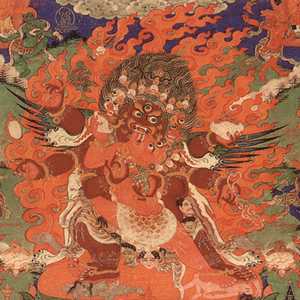
John Myrdhin Reynolds on What You See Is What You Are
The following article is adapted from
Self-Liberation through Seeing with Naked Awareness
Translated with commentary by John Myrdhin Reynolds
Whether we see the world as chaos or as a divine mandala depends on the states of our minds, says John Myrdhin Reynolds in this adaptation from Self-Liberation through Seeing with Naked Awareness.
All of us here in this lifetime are experiencing human karmic vision because we all possess in common the cause for such a vision. Therefore, we share this common vision. But this is not so with beings in other destinies of rebirth whose vision possesses different causes. For example, when we humans look at a river in summer, it appears to us to consist of cool and refreshing water. But to a Deva, who possesses a different kind of vision, the river seems to consist of fragrant sweet-tasting divine nectar. On the other hand, to a Preta or hungry ghost it seems to be a sluggish stream of foul-smelling excrement, and to a denizen in hell it seems to be a river of molten lava. In this way, external appearances are perceived by living beings in such a way as is determined by internal karmic causes. The same river is perceived quite differently by beings in different dimensions of existence.
But when our mind is transformed, all external appearances are transformed. If these two, Samsãra and Nirvana, arise to us as reflections of our mind, then when our mind is transformed, when impure karmic vision is transformed into pure vision, the one will seem to change into the other. Instead of the usual chaotic mess which is the world around us, we perceive everything as the pure mandala of the Buddha. This is the principle of tantra: transformation. This, of course, indicates something much more radical and profound than a superficial visualization of a wish-fulfillment fantasy: it is a radical transformation at the very root of the mind. But here in this context, the meaning is a bit different. In the Tantras a great deal of diligence and effort in meditation is required, a great deal of practice in clear visualization. But in Dzogchen, there is nothing to be transformed, nothing to be visualized such as beautiful mandalas and magnificent deities, nothing at all to be constructed by the mind, because all appearances are already spontaneously self-perfected from the very beginning.
All this is very easy to say. But external appearances seem to us to be very much real, very solid and substantial. It seems that there must be something actually out there and not just empty space, incredibly cluttered up with phantom projections of the mind. Why do appearances seem to be so solid and real? We must understand that it is the mind that grasps at appearances, at their reality and their substantiality. But these seemingly solid appearances are empty, being only space; they are nothing in themselves, save in the context of their relations to everything else. As distinct concrete isolated entities with their own individual reality they are nothing. And in terms of this, there is no error in them; rather the error lies in our grasping at them as real. It is this grasping that leads to attachments and aversions; this is the problem and not the things in themselves. But if we can come to understand that no matter how long we search, no matter how far we wander in this quest, we will not find anyone there who is doing the grasping, then we will discover liberation in that very fact. Whatever arises and whatever is liberated are only appearances of mind (sems kyi snangba).
John Myrdhin Reynolds (Vajranatha) is a writer teacher translator and scholar/practitioner of Tibetan Buddhism. He was trained and ordained as a Tantric Yogin or Ngagpa in the Nyingma tradition of Tibetan Buddhism.
Related Books on Liberation in the Tibetan Buddhist Bardo Teachings
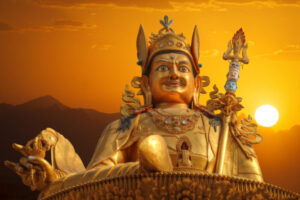
Guru Rinpoche: His Life and Times
| The following article is from the Spring, 2002 issue of the Snow Lion Newsletter and is for historical reference only. You can see this in context of the original newsletter here. |
See also our Reader's Guide to Guru Rinpoche Padmasmbhava with a full list of resources.
Guru Rinpoche: His Life and Times
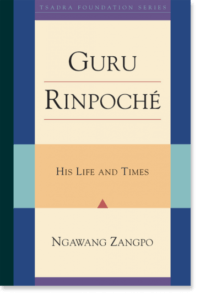
by Ngawang Zangpo
About this Book
To Tibetan Buddhists Guru Rinpoche is a Buddha. In 763, Tibet's powerful armies overran the capital of China and installed a puppet emperor. Why didn't Tibet continue its aggressive military campaigns? This transformation was due to Guru Rinpoche who tamed and converted Tibet to Buddhism and thereby changed the course of Asian history.
This book recounts Guru Rinpoche's historical visit to Tibet and explains his continuing significance to Buddhists. Four very different Tibetan accounts of his story are presented:
Buddhist accounts:
A Biography of Guru Rinpoche by Jamgon Kongtrul
The Immaculate While Lotus by Yeshe Tsogyal
One according to the pre-Buddhist Tibetan religion, Bon:
The Bon Version of the Life of Guru Rinpoche by Jamyang Khyentse Wangpo
One based on Indian and early Tibetan historical documents:
The Indian Version of the Life of Guru Rinpoche by Taranata.
In addition, there are supplications by Guru Rinpoche and visualizations to accompany them by Jamgon Kongtrul.
Praise for Guru Rinpoche: His Life and Times
"The presence of Guru Rinpoche, a figure so important to Tibetan Buddhists he is called simply 'The Precious Master', can be felt still in each of these liberating stories translated here. Read side-by-side, they reveal an even wider picture, deftly highlighted by Ngawang Zangpo's introduction, of how history and culture interact with the inner spirituality that is beyond time and place."— Sarah Harding, author of Creation and Completion
"With a thought-provoking introduction and stimulating cultural, religious, and literary insights, Ngawang Zangpo offers welcome translations of four biographies of Gum Rinpoche and a set of famous supplications. This new work will certainly be enjoyed by everyone interested in the vast spiritual legacy of the Second Buddha' in Tibet." —Cyrus Stearns, author of Buddha from Dolpo
Ngawang Zangpo (Hugh Thompson) lives near Santa Cruz, California. His previous works include Sacred Ground: Jamgon Kongtrul on Pilgrimage and Sacred Geography.
Persons who cannot force themselves to board an airplane cannot fly; people who cannot accept a relationship based on faith and devotion cannot practice tantra.
Excerpt From Guru Rinpoche: His Life and Times
Non-Tibetans can now meet Guru Rinpoche, but the encounter can only be meaningful with faith. Our faith and devotion provide the only access possible to the timeless, ever-present Guru Rinpoche, and this faith and devotion must begin in relation to a human spiritual master and a lineage. For some people this is an impossible task, which should not be a problem unless they imagine they want to practice tantra. Persons who cannot force themselves to board an airplane cannot fly; people who cannot accept a relationship based on faith and devotion cannot practice tantra. Dzongsar Jamyang Khyentse Rinpoche writes in the same book:
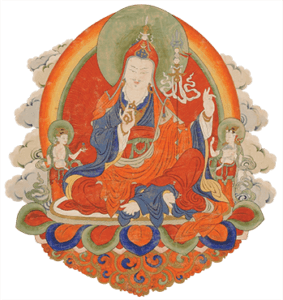
The purpose of Dharma practice is to attain enlightenment. Actually, attaining enlightenment is exactly the same as ridding ourselves of ignorance, and the root of ignorance is the ego. Whichever path we take, whether it's the long and disciplined route, or the short and wild one, at the end of it the essential point is that we eliminate ego.
There are many, many different ways we can do this, for example through Shamatha [tranquility] meditation, and they all work to one extent or another. However, since we have been with our ego for so many lifetimes and we are so familiar with it, every time we take to a path in our efforts to eliminate ego, that very path is hijacked by ego and manipulated in such a way that rather than crushing our ego, our path only helps to reinforce it.
That is the reason why, in the Vajrayana, guru devotion, or Guru Yoga, is taught as a vital and essential practice. As the guru is a living, breathing human being, he or she is able to deal directly with your ego. Reading a book about how to eliminate ego may be interesting, but you will never be in awe of a book, and anyway, books are entirely open to your interpretation. A book cannot talk or react to you, whereas the guru can and will stir up your ego so that eventually it will be eliminated altogether. Whether this is achieved wrathfully or gently doesn't matter, but in the end this is what the guru is there to do, and this is why guru devotion is so important.
I believe that all tantric Buddhists should be as frank as this master about their path and what sets it apart from the other Buddhist paths: faith and devotion to the spiritual master. In Sanskrit they say, "Guru Yoga;" in English we might say, "communion with the spiritual master's mind." Tantra takes pride in its plethora of practices: it aims to answer everyone's needs with easy, accessible, and efficient ways to enlightenment. Yet every single one of those skillful means depends on the spiritual master, a human being from whom we receive transmission of empowerment, the lineage, and guidance; and, after we receive instruction, our success or failure depends not on our diligence, not on our goodness, and not on our intelligence, but on our faith and devotion to our spiritual master.
Tantra cannot be all things to all people. Some of us have serious issues with a relationship grounded in the intense devotion tantra demands. It is in no way a judgment of those individuals or of tantra to say that they were not made for one another. Tantra is not to everyone's taste, nor can it ever be made to be.
"...attaining enlightenment is exactly the same as ridding ourselves of I ignorance, and the root of ignorance is the ego. Whichever path we take, whether it's the long and disciplined route, or the short and wild one, at the end of it the essential point is that we eliminate ego."
Guru Rinpoche is for most Himalayan Buddhists the second Buddha, the Buddha of every form and teaching of enlightenment, with an accent on the tantras. Just as the Great Way teaches us to identify our enlightened nature and call it buddha-nature, tantra teaches us to first see our teachers as Guru Rinpoche. Then we see all phenomena as Guru Rinpoche, down to every atom of our own body, every atom of all beings equally, and every atom of every blade of grass, every grain of sand. Finally, when we recognize our own innate, timeless awareness, it as well is none other than Guru Rinpoche.
Dzongsar Jamyang Khyentse Rinpoche writes:
The first stage of guru devotion, then, is to awaken and enhance our devotion, until it becomes sound and strong and we can actually look upon the guru as the Buddha.
Gradually we will reach the second stage, where we don't simply think the guru is the Buddha, we see he is the Buddha. As our devotion becomes stronger still, it is with a growing sense of joy that we begin to rely entirely on the guru for everything. An inner confidence arises, an absolute certainty that the guru is the only source of refuge. No longer do we have to create or fabricate our devotion now it comes quite naturally.
Then, all our experiences, good or bad, are manifestations of the guru. Everything we experience in life becomes beneficial and has a purpose; everything we encounter becomes a teaching. Total trust and devotion for the guru is born within our heart, and the blessing of the guru dissolves into our mind.
With this, we reach the third stage, which is when we realize that our mind is none other than the guru whom we have seen as the Buddha.
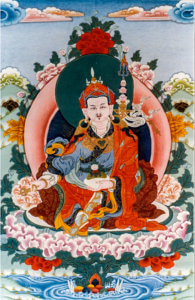
This Guru Rinpoche, while timeless, is introduced to us thanks to a lineage of masters who have passed on their wisdom in an uninterrupted stream to the present. In the preface to Masters of Meditation and Miracles, Tulku Thondup makes a statement that should be repeated in every Tibetan translation:
It was improper and indeed impossible for me to try to avoid the typical characteristic of Tibetan biographies, namely the inclusion of endless lists of teachers, teachings, and disciples of the masters, even though those lists might be boring for readers who are not Tibetan.
He then traces the lineages from Guru Rinpoche and other great masters down to the present, each an essential link. Each deserves to be honored by our attention. How many of us learned (or still learn?) the names of members of sports teams, or of rock bands, or of political parties, during their fleeting moments of fame and fortune? We definitely have the capacity to learn the names and personal histories of the enlightened individuals who have contributed to the wisdom bridge that reaches us.
The members of lineages from Guru Rinpoche should not be faceless, nameless persons: they have kept real and alive what is most important to us the full presence and blessing of Guru Rinpoche.
Lineages of wisdom have been compared to electricity that flows from a power plant to one's home: If the flow is interrupted or faulty at any point, the flow of electricity will stop. The members of lineages from Guru Rinpoche should not be faceless, nameless persons: they have kept real and alive what is most important to us the full presence and blessing of Guru Rinpoche. Different masters reflect the needs of their time on a superficial level, and thus might seem foreign to us, but the wisdom-electricity we receive from our teachers has passed through them and, thanks to them, is exactly the same as it was a thousand years ago.
Guru Rinpoche first appeared as an Indian, a guise that caused his expulsion from Tibet. Yet, with some more reflection over time, Tibetans came to worship Indian spirituality and Indian masters. To the present day, the focus of Tibetan Buddhism remains fixed not upon indigenous Tibetan masters, however impressive they were, but upon non-Tibetans, Buddha Shakyamuni and Guru Rinpoche.
These days, Guru Rinpoche first appeared to us primarily in a Tibetan guise. The Tibetan masters' priceless gift to us has been to introduce foreigners worldwide to Guru Rinpoche's timeless wisdom in such ways as to make it comprehensible, attractive, and accessible. They have had to confront in their new students many non-conducive attitudes, such as distrust, self-seriousness and solemnity, but they disarmed and relaxed us with their light humor, gentle warmth, and sincere concern (or love, to be more precise). Not only did they bring Guru Rinpoche into our lives, they made it seem that the most natural, clear-headed, and light-hearted thing to do is to discover eternal Guru Rinpoche within ourselves. What we saw as insurmountably distant proved to be innate, and what intimidated us proved to be child's play.
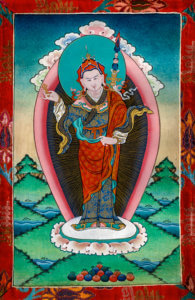
What we saw as insurmountably distant proved to be innate, and what intimidated us proved to be child's play.
Modern spiritual masters of all races now bring Guru Rinpoche to our level, but that is not to say that it would not be wise for us, on our part, to rise to the occasion. If you feel the urge to do yourself an enormous favor, attend any lecture by the Dalai Lama (or so many other tantric masters I could name) when he visits your continent. Or plunge into Journey to Enlightenment, Matthieu Ricard's book on the life of Dilgo Kyentse Rinpoche.
These masters, who introduce us so surely and gently to what has always been our nature, making it seem so familiar and close, provide living proof of the wondrous qualities of that same nature's manifest expression, which surpass all measure and understanding.
Who are these unfathomable beings if they are not Guru Rinpoche?
I cite them because they are persons of living memory, whom we can meet in person or in photographs or in words spoken directly in English, and I mention them because, they present us with a paradox. On the one hand, our recognition of our inner nature must accompany us on a "kitchen-sink level," as Trungpa Rinpoche used to remind us, and yet our inner Guru Rinpoche's positive qualities are what, we call, for lack of better words, inconceivable and inexpressible. These masters, who introduce us so surely and gently to what has always been our nature, making it seem so familiar and close, provide living proof of the wondrous qualities of that same nature's manifest expression, which surpass all measure and understanding.
Ngawang Zangpo (Hugh Leslie Thompson) completed two three-year retreats under the direction of the late Kalu Rinpoche. He is presently working on a number of translation projects that were initiated under the direction of Chadral Rinpoche and Lama Tharchin Rinpoche. He has also contributed to Kalu Rinpoche's translation group's books Myriad Worlds and Buddhist Ethics.
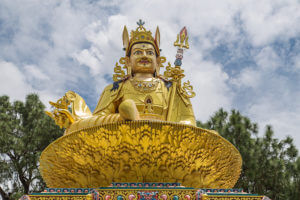
Padmasambhava (eighth century), the Indian meditation master, is the founder of the Nyingma tradition, the oldest Buddhist tradition in Tibet. In addition to introducing the practices of tantric Buddhism to Tibet, he also completed the building of Samye, the first Buddhist monastery in Tibet.
More Books by Ngawang Zangpo
Other Books Related to Guru Rinpoche
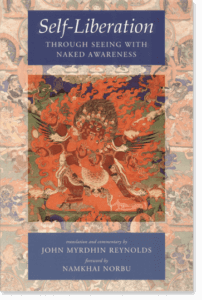
Self-Liberation Through Seeing With Naked Awareneness
| The following article is from the Autumn, 2000 issue of the Snow Lion Newsletter and is for historical reference only. You can see this in context of the original newsletter here. |
by John Myrdhin Reynolds
fore, by Namkhai Norbii
171 pp., 4 line drawings, glossary,
biblio., index. #SELI $14.95
A text belonging to the same cycle as The Tibetan Book of the Dead, this instruction on the method of self-liberation presents the essence of Dzogchen, the Great Perfection, regarded in Tibet as the highest and most esoteric teaching of the Buddha
Teaching the attainment of Buddhahood in a single lifetime, this text was written and concealed by Guru Padmasambhava in the eighth century and rediscovered six centuries later by Karma Lingpa. The commentary by the translator is based on the oral teachings of Namkhai Norbu Rinpoche and Lama Tharchin Rinpoche.
If you understand intrinsic awareness, all of your merits and sins will be liberated into their own condition.... If he practices, then even a cowherd can realize liberation.
JOHN MYRDHIN REYNOLDS (Vajra- natha) is a writer, teacher, translator, and scholar/practitioner of Tibetan Buddhism. He was trained and ordained as a Tantric Yogin, or Ngagpa, in the Nyingmapa tradition of Tibetan Buddhism. He has taught widely in the United States and Europe. He is also the author of The Golden Letters.
Foreword
by Namkhai Norbu Rinpoche
In the eighth century of our era, the master from the country of Uddi- yana, Guru Padmasambhava, who was the individual principally responsible for establishing the teachings of the Buddhist Tantras in Tibet, gave to his group of disciples there many vast and profound teachings related to both Tantra and Dzogchen. But since the Tibetan people were not ready for all of these teachings, many of which were more directly suited to future generations, he had his consort, the Tibetan princess Yeshe
Tsogyal, write them down and hide them in various places throughout the country. Such deliberately concealed texts are known as Termas or hidden treasures. Those among his original group of disciples who were reborn in later generations in order to rediscover these texts are known as Tertons, those who reveal hidden treasures. The appearance of Termas and Tertons during the following centuries, including the present one, has been a source of unending benefit and blessing for the Tibetan people and represents the continuing revelation of the highest teachings of the Tantras and Dzogchen.
In the fourteenth century of our era, there appeared a great Terton by the name of Nyida Sangye. His eldest son in turn became a great Terton by the name of Karma Lingpa. When he was fifteen years old, from a location on the mountain of Gam-po-dar, which looks like a dancing attendant deity, in eastern Dwagpo, he discovered many profound teachings, principally the Zob-chos zhi-khro dgongs pa rang-grol, otherwise known as the Kar-gling zhi-khro.
This cycle of texts of the Kar-gling zhi-khro represents an introduction to the state of Dzogchen, the Great Perfection. Dzogchen is not the name of a religion, philosophy, school, or sect but the Primordial State of the individual. The essence of the teachings of all the Buddhas is the understanding of this state, which is the nature of one's own mind. Among different schools this Primordial State has many different name Prajnaparimita, Tathagatagarbha, Bodhichitta, or Mahamudra. Among Tibetan Buddhists of the old school, the Nyingmapas, and also among the Bonpos, it is generally known as Dzogchen, which means the Great

...we first need transmission from a realized master in the form of an introduction (ngo-sprod) to the state of presence and awareness (rigpa), which is the capacity of the nature of mind. This introduction, a meeting face-to-face, is precisely the function of the present text, which reports the very words of Guru Padmasambhava.
Perfection. It is also called tha-mal gyi shes-pa, which means ordinary awareness; but this is not our ordinary mind incessantly thinking of this or that throughout the day. In Dzogchen we make a radical and fundamental distinction between mind (sems) and the nature of mind (sems nyid); and here ordinary awareness refers to the latter. The nature of the mind is like a mirror which has the natural and inherent capacity to reflect whatever is set before it, whether beautiful or ugly; but these reflections in no way affect or modify the nature of the mirror. It is the same with the state of contemplation: There is nothing to correct or alter or modify (ma bcos-pa). What the practitioner does when entering into contemplation is simply to discover himself in the condition of the mirror. This is our Primordial State. But in order to recognize it, we first need transmission from a realized master in the form of an introduction (ngo-sprod) to the state of presence and awareness (rigpa), which is the capacity of the nature of mind. This introduction, a meeting face-to-face, is precisely the function of the present text, which reports the very words of Guru Padmasambhava introducing his disciples to such presence or awareness. Hence this text, which is the root text of the Kar-gling zhi-khro cycle, is called Rig-pa ngo sprod. By means of Rigpa we come to see everything with a direct immediate presence, denuded of the judgments and conceptual constructions that usually obscure our vision and obstruct our understanding. And in this way, we come to realize self-liberation (rang grot). In the state of contemplation, when a thought arises, it is allowed to self-liberate into its own condition, without any effort or attempt at modification. Whereas the method of the Sutras is the path of renunciation and the method of the Tantras is the path of transformation, the method proper to Dzogchen is the path of selfliberation, as is made clear in the teaching of Padmasambhava that we have here. This text, the Rig-pa ngo-sprod gcer-mthong rang-grol, which is part of the cycle of the Zab-chos zhi-kbro dgongs-pa rang- grol, provides the essential view for this entire cycle of teachings relating to the six Bardos or intermediate states of existence. The Kar-gling zhi-khro is the most complete of all Zhi-khro (or Bardo) teachings and is widely known and used, especially among the Nyingmapa and the Kagyudpa schools. These teachings continue to generate activities for the benefit of beings, and in no way have they been exhausted.
Self-Liberation through Seeing with Naked Awareness
$24.95 - Paperback
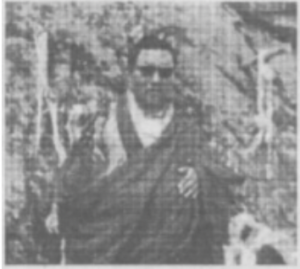
| The following article is from the Spring, 1998 issue of the Snow Lion Newsletter and is for historical reference only. You can see this in context of the original newsletter here. |
Azom Chotrul Paylo Rinpoche and the Legacy of Chimphu
Yarlung Valley, Tibet
In eighth-century Tibet, Buddhism was dawning in the fertile Yarlung Valley, home to Tibet's earliest kings. Teachings whose time was not yet ripe, tradition tells us, were being hidden by the dakini Yeshe Tsogyal. Many of these were instructions she received from Padmasambhava when they did retreat in places to the east, like Terdrom, and above all in the caves of Chimpu above Samyé, where the first monastery of Tibet had just been built.
MANY WONDERFUL IMAGES CAN BE SEEN IN THE ROCKS THERE; THE SCULPTED FORMS OF BUDDHAS AND YOGIS ARE SAID TO HAVE EMERGED SPONTANEOUSLY THROUGH BLESSINGS BROUGHT BY THE GREAT PRACTITIONERS WHO CAME HERE.
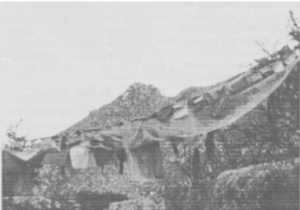
Chimphu is formed around a high narrow valley, crested on three sides by rock formations studded with caves. Since the earliest days of Buddhism in Tibet, if not before, these caves have sheltered meditators in retreat. Many wonderful images can be seen in the rocks there; the sculpted forms of Buddhas and yogis are said to have emerged spontaneously through blessings brought by the great practitioners who came here.
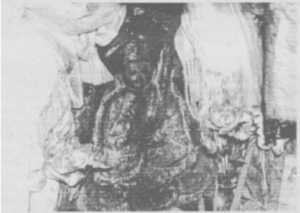
Related Books
The Dakini Heart Essence Teachings
Among other significant events that, according to Nyingma traditions, took place at Chimphu was the sudden death of the King Trisong Deytsen's eight-year-old daughter, Lhacham Pemasel (also known as Princess Pema Sal). As her mother swoons in the arms of Yeshe Tsogyal, Padmasambhava briefly revives the young girl and inscribes on her heart a vermilion letter HRI, telling her stricken parents that because of this she will, many lifetimes from now, come to discover Padmasambhava's own heart essence teachings in a transmission that will become known as the Dakini Heart Essence teachings.
Yeshe Tsogyal is instructed to hide these teachings away so that the Princess' future incarnation will be able to discover them. Until they are discovered, it will be another lineage, the Vimalamitra Heart Essence, which will flourish.
In the 13th century Pema Ledrel Tsel reveals two volumes known as The Dakini Heart Essence, Khadro Nying Tig (Khandro Nyingtig), which include the tale of how this transmission was initially bestowed on the heart of the young princess, his former incarnation.
This transmission is also held by the third Karmapa, Rangjung Dorje, and eventually by the great 14th century adept Longchenpa Rabjam who unifies this transmission with the earlier Heart Essence of Vimalamitra.
When Longchenpa visited Chimphu he declared,
I would rather die here than be born somewhere else.
And after doing retreat and giving teachings, he did die at Chimphu in 1363. One can still visit his stupa there.
THE DAKINIS HOLD THIS TEACHING AS DEAR AS A DROP (ESSENCE) OF BLOOD IN THEIR OWN HEART.
In the 18th century, Jigme Lingpa, also recognized as a reincarnation of the young princess, did a three-year retreat at Chimpu. He spends some of this period in the sleeping cave of Yeshe Tsogyal, travels by vision to the great stupa of Boudha, where with the support of many dakinis he receives through visionary encounter with Longchenpa the lineage now known as The Heart Essence of the Vast Expanse, Longchen Nying Thig. It gets its name, Khetsun Sangpo Rinpoche once said,
"...because the dakinis hold this teaching as dear as a drop (essence) of blood in their own heart."
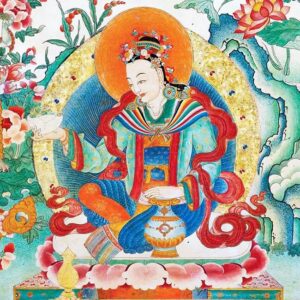
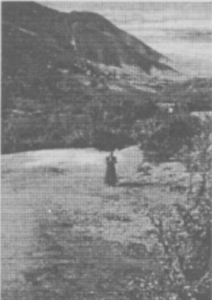
The Beginning of my Practice
I began practice in this lineage under Khetsun Sangpo Rinpoche in 1974. As I was led, over the next two and half decades, through the stream of practices in this transmission, I began to plan a pilgrimage to Tibet that would center on places sacred to Yeshe Tsogyal, Padmasambhava, and this lineage.
A few months before the pilgrimage began in May of 1996, I woke up from a strong dream of Longchenpa Rabjam and Jigme Lingpa, the first time I had ever dreamt of them. Perhaps it was not too surprising. In conversation with my friend Phyllis Pay, I had been dreaming the trip deeply for nearly a year, exploring various locations that we might visit.
Our trip began in Lhasa, and our first camping excursion was planned for Chimphu, which we approached by way of Samye. On the truck that took us from Samye to Chimphu were a number of nuns from Shugseb, where Khetsun Sangpo Rinpoche had received transmission of the Heart Essence of the Great Expanse from the great female yogini, Ani Lochen.
One young nun was wearing a button with a Lama's face on it. I asked her about it.
"This is a great Lama who is now visiting and giving teachings at Chimphu. We have all come to hear him."
She assured me that we could meet him, and gave directions how to find him.
We pitched our tents on a green carpet of grass by a rushing stream–its waters probably mingling with a spring higher up the mountain said to have emerged during Guru Rinpoche's first teachings there. It rained during the night, leaving a film of radiant snow on the high cliffs above us.
After breakfast, we hiked up the rise behind our meadow. Azom Rinpoche was staying in a small monastery about five hundred feet above where we had camped at Chimphu, and perhaps 800 feet below the sleeping cave of Yeshe Tsogyal.
He was teaching the higher practices contained in the Heart Essence of the Vast Expanse to 250 Tibetans who were practicing in upper Chimphu. These monks and nuns came down every other day for teachings, walking contentedly in twos and threes, chanting a beautifully haunting song, a call to the Lama, that floated through the clear air between the high cliffs before wafting down the valley.
On alternate days newer students, staying in tents on the elevated flat areas near the monastery, received teachings on the foundational practices of the lineage. We eleven were the only non-Tibetans in the area.
We entered his room, eyes dilating after the brilliant light outside. He was attended by two monks and sat energetically at the foot of his wooden bed as he received our offering scarves. We bowed down and introduced ourselves. After mentioning the various connections each of us had with practice, I asked whether we might receive instructions on the mind-nature from him.
These are especially precious teachings, usually given to relatively practiced students and potentially precipitating a significant turning point in understanding. His response was immediate:
"Shall I speak to the whole group at once or to each of you individually?"
"One by one please," we asked.
"Yes, that's best," he said, "because everyone is different. How could I say the same thing to all of you?"
And so we began. My friend Michele Martin and I translated. This meant that, in addition to receiving our own teachings, we were able to see him work with the other women.
He usually began by asking a question, and would respond to the answers in ways that led each person gently and quite directly, by a route unique to her situation, to the essence he wished to impart. He often closed by giving instructions on a simple meditation practice that he felt addressed the person's situation and invited her to return next day for further instructions.
OUR ENCOUNTER AT CHIMPHU PROMISES NOW TO FLOWER INTO A WONDERFUL OPPORTUNITY TO SUPPORT HIS VITAL ACTIVITIES IN TIBET AND TO ALLOW WESTERN PRACTITIONERS TO MAKE A CONNECTION WITH HIM AND THE ANCIENT TRANSMISSIONS HE HOLDS.
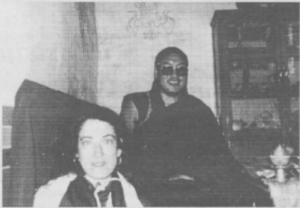
Azom Rinpoche's Previous Incarnations
Before the individual sessions began, however, and in response to our own introductions, Azom Rinpoche had also been introduced. His attendants took it upon themselves to read to us from an ornately phrased English biography which stated that three days after his birth Azom Rinpoche began to speak in so loving a manner that people were left in joy and astonishment, and at the age of one year he was recognized by the Abbot of Azom Monastery as an incarnation of Gyalsey Pema Wangyal, son of the previous Azom Rinpoche.
The attendant then proceeded to read a short list of the other various personages incarnated in him. One is Trisong Daytsen, father of the young Princess who died at Chimphu. Another, the monk continued, was none other than Jigmay Lingpa.
Azom Rinpoche began his studies at the age of five. Clearly an extraordinary prodigy, he undertook full time retreat at eleven, began teaching at thirteen, and now at age of twenty-six has 10,000 Tibetan and Chinese followers.
He is widely renowned for having left hand prints in rock in Kham, and has been photographed before a wooden staff he inserted into rock after a powerful ceremony.
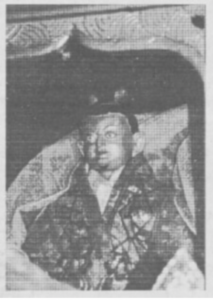
Restoring Tibet's Retreat Centers
He came to central Tibet in order to restore important retreat centers destroyed during the Cultural Revolution.
In particular, he has commenced the rebuilding of Zha Lhakang on the border or Kham and Central Tibet. This was originally built only 35 years after Samye, Tibet's first monastery, and was famously rebuilt by Longchen Rabjam in the fourteenth century. In 1997, Azom Rinpoche commenced rebuilding Zha Lhakang on the anniversary of Longchen Rabjam's reconstruction. This place is considered very important because it is said to act as a barrier, protecting the Dharma of Tibet.
In addition to this work, Azom Rinpoche supports several thousand monks and nuns. He asked me to help him raise money for these worthy projects, and after much thought it seemed best to invite him to this country so that people here could benefit from his powerful teachings, and also so that he could gather funds for his important work.
As a result of our fortuitous meeting, Dawn Mountain Tibetan Temple in Houston organized the first U.S. visit of Azom Rinpoche.
Certainly, our encounter at Chimphu promises now to flower into a wonderful opportunity to support his vital activities in Tibet and to allow Western practitioners to make a connection with him and the ancient transmissions he holds.

For more information go to Dzogchen Cycles Adzom Lineage
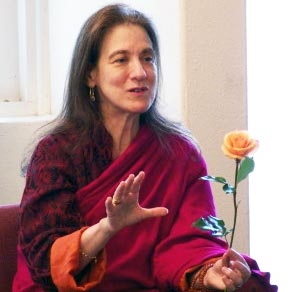
Anne C. Klein is professor and chair of Religious Studies at Rice University. She is also a founding director and resident teacher of Dawn Mountain, a center for contemplative study and practice in Houston. Her publications include Path to the Middle (SUNY Press), Unbounded Wholeness, coauthored with Geshe Tenzin Wangyal Rinpoche (Oxford University Press), and Knowledge and Liberation (Snow Lion Publications).
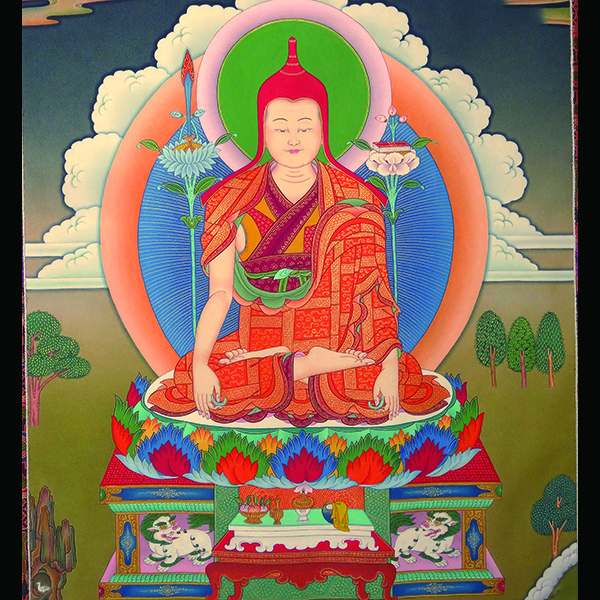
Longchen Rabjam (1308–1363), also known as Longchenpa, is a great luminary of Tibetan Buddhism. He was highly skilled in all aspects of scholarship from an early age and excelled throughout his life in the practice and accomplishment of the Dharma. Regarded as a great Dzogchen master, Longchenpa had many pure visions where he was given direct instructions from Guru Padmasambhava and is recognized as an emanation of Vimalamitra. Longchenpa’s prolific writings have made him one of Tibet’s most renowned and precious teachers.
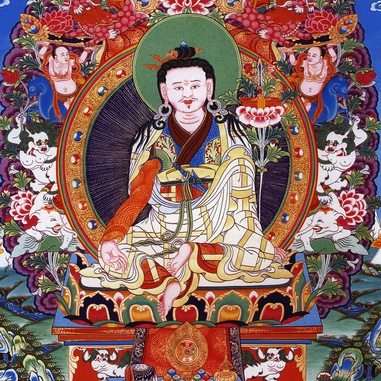
Rigdzin Jigme Lingpa (1730–1798) was a great master of the Nyingma tradition of Tibetan Buddhism. The root of the Khyentse lineage, he was a tertön, or discoverer of treasure teachings, and revealed the Longchen Nyingtik, one of the most important cycles of meditative practice in the Nyingma school.
Khetsun Sangpo (1921–2009) was born in central Tibet and worked in a monastery as a servant when he was a boy, learning to read and write during his free hours. He later pursued study for several years with a renowned nun. (It was unusual for a man to seek teachings from a woman.) He eventually pursued formal monastic education in both the Gelukpa and Nyingma traditions. He fled Tibet to India in 1959. He had a close relationship with Dudjom Rinpoche, who asked him to teach in Japan for ten years as his representative. After that period, he spent the rest of his life in India and Nepal.

